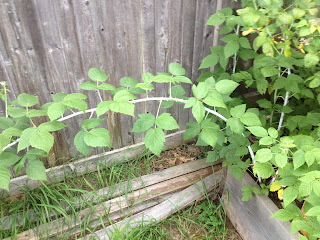Black Raspberries
Though we still haven't reaped many blueberries from our new stock, the raspberries this year are awesome. We even have black raspberries for the first time, since this spring we remembered to prune them properly. Black raspberries grow differently than red ones:
The canes are more silvery, and when they arch over and touch the ground, they'll set new roots and form a brambly hedge. If you prune them back, they'll send out more side branches instead. We'll get to this one after the fruiting is done.
Black raspberries also spend a good portion of their lives looking an awful lot like red raspberries:
If you aren't paying attention and think that those pretty red berries are ready to eat, you will be disappointed in a particularly face-puckering way. Unripe black raspberries are almost inedibly sour.
If you are paying attention, though, you notice that black raspberries grow together in upward facing clusters, and this bit of knowledge will keep you from eating terrible fruit by mistake. None of the berries in that cluster above is ready to pick, by the way. The one that looks almost ripe is still a little purple instead of really black, so it too will be terribly sour. You really have to wait until they're totally black with no translucent bits of purplish light shining through—then they're delicious.
For contrast, real red raspberries hang down downward when they're ripe, and they're not as tightly clustered:
We have only two black raspberry plants, and this is the first season we've had any black raspberries to speak of. It's not enough to make a jam or anything, but they taste so good right off the vine (when they finally are ripe) that we just eat them right up any way. It's been a great season for raspberries, one of our fruit success stories.






Comments
Post a Comment